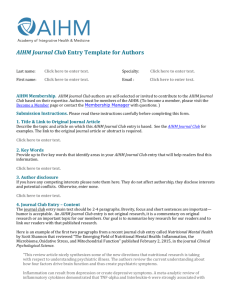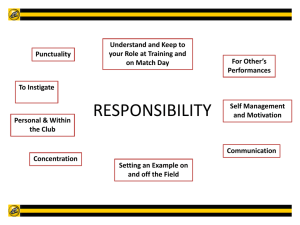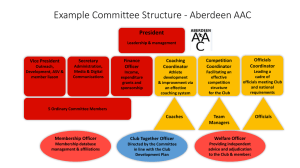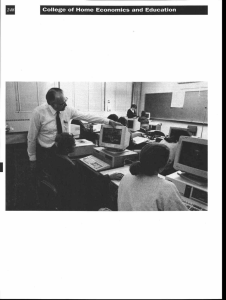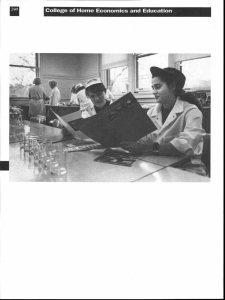AIHM-JC-Author-Instructions
advertisement
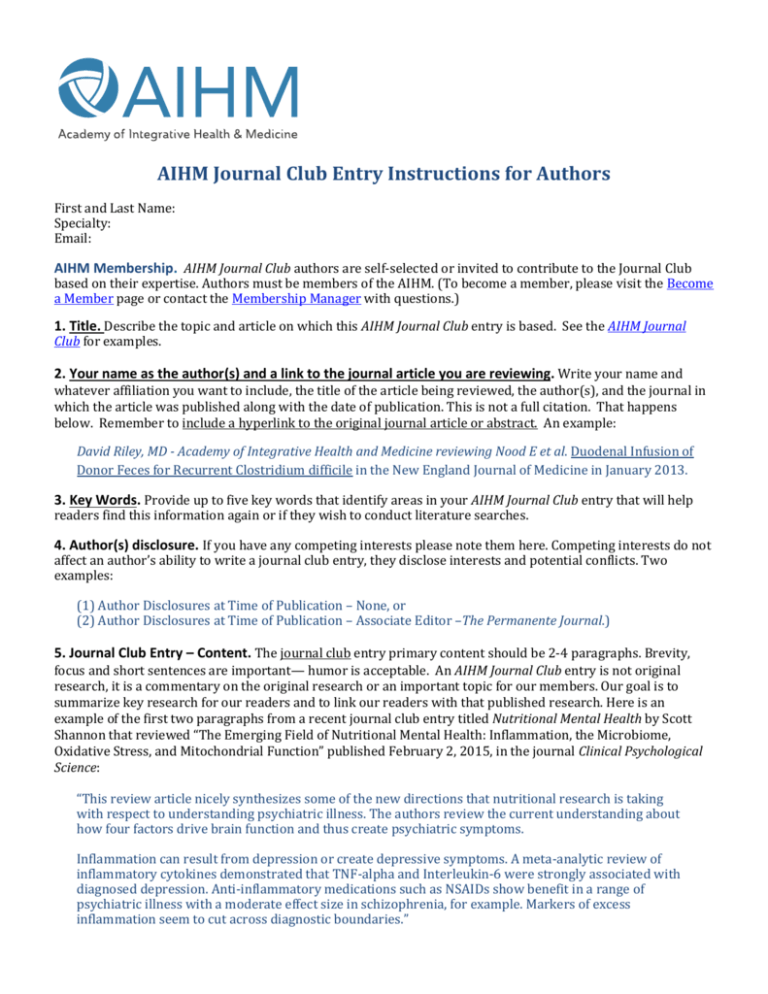
AIHM Journal Club Entry Instructions for Authors First and Last Name: Specialty: Email: AIHM Membership. AIHM Journal Club authors are self-selected or invited to contribute to the Journal Club based on their expertise. Authors must be members of the AIHM. (To become a member, please visit the Become a Member page or contact the Membership Manager with questions.) 1. Title. Describe the topic and article on which this AIHM Journal Club entry is based. See the AIHM Journal Club for examples. 2. Your name as the author(s) and a link to the journal article you are reviewing. Write your name and whatever affiliation you want to include, the title of the article being reviewed, the author(s), and the journal in which the article was published along with the date of publication. This is not a full citation. That happens below. Remember to include a hyperlink to the original journal article or abstract. An example: David Riley, MD - Academy of Integrative Health and Medicine reviewing Nood E et al. Duodenal Infusion of Donor Feces for Recurrent Clostridium difficile in the New England Journal of Medicine in January 2013. 3. Key Words. Provide up to five key words that identify areas in your AIHM Journal Club entry that will help readers find this information again or if they wish to conduct literature searches. 4. Author(s) disclosure. If you have any competing interests please note them here. Competing interests do not affect an author’s ability to write a journal club entry, they disclose interests and potential conflicts. Two examples: (1) Author Disclosures at Time of Publication – None, or (2) Author Disclosures at Time of Publication – Associate Editor –The Permanente Journal.) 5. Journal Club Entry – Content. The journal club entry primary content should be 2-4 paragraphs. Brevity, focus and short sentences are important— humor is acceptable. An AIHM Journal Club entry is not original research, it is a commentary on the original research or an important topic for our members. Our goal is to summarize key research for our readers and to link our readers with that published research. Here is an example of the first two paragraphs from a recent journal club entry titled Nutritional Mental Health by Scott Shannon that reviewed “The Emerging Field of Nutritional Mental Health: Inflammation, the Microbiome, Oxidative Stress, and Mitochondrial Function” published February 2, 2015, in the journal Clinical Psychological Science: “This review article nicely synthesizes some of the new directions that nutritional research is taking with respect to understanding psychiatric illness. The authors review the current understanding about how four factors drive brain function and thus create psychiatric symptoms. Inflammation can result from depression or create depressive symptoms. A meta-analytic review of inflammatory cytokines demonstrated that TNF-alpha and Interleukin-6 were strongly associated with diagnosed depression. Anti-inflammatory medications such as NSAIDs show benefit in a range of psychiatric illness with a moderate effect size in schizophrenia, for example. Markers of excess inflammation seem to cut across diagnostic boundaries.” 6. Commentary. Comment on why and how this article and topic are important and relevant to clinicians interested in integrative health and medicine. What are the 'take-away' messages in 3-5 sentences and 1-2 paragraphs? An example of a commentary from the above Journal Club entry by Scott Shannon: “For the last sixty years, psychiatric research and practice has focused on the use of psychiatric medications to treat mental health disorders. Over the last ten years it has become clear that our expectations of sustained dramatic improvements are not being met. Three massive publically funded studies (CATIE, STEP-BD, STAR*D) have pointed out the limitations of modern psychiatry. Over the last five years the direction of psychiatric research has moved from neurotransmitters (soup) to the interconnections (circuits) that drive symptom pattern. The chemical imbalance theory on mental illness revered in the 1990s now seems (to quote this paper), “impossibly superficial and vague by 21st century standards.” Thomas Insel, MD, the Director of NIMH, alerted the world in April of 2013 just prior to publication of DSM-5 that NIMH would no longer use the DSM in research because it was simply too superficial and based solely on symptom patterns. He felt that psychiatry needed to address underlying core mechanisms if we were to go beyond phenomenology. This paper documents how modern psychiatry can approach that laudable goal. The fact that this paper was published in a psychology journal echoes the inherent resistance of this field to these considerations.” 7. Citations. List the article(s) you reviewed to write your AIHM Journal Club entry. Other relevant publications or websites may be included. Include a hyperlink to the original journal article or abstract. Here is an example from the AIHM Journal Club entry mentioned above: • Kaplan BJ, Rucklidge JJ, Romijn A, and McLeod, K “The Emerging Field of Nutritional Mental Health: Inflammation, the Microbiome, Oxidative Stress, and Mitochondrial Function.” Clinical Psychological Science, February 2, 2015, doi: 10.1177/2167702614555413 8. Excerpt. This is important for social media. Your excerpt should be a concise (one-to two-sentence) summary of the entry that will be used by AIHM in their social media channels to promote your contribution. May 10, 2015
